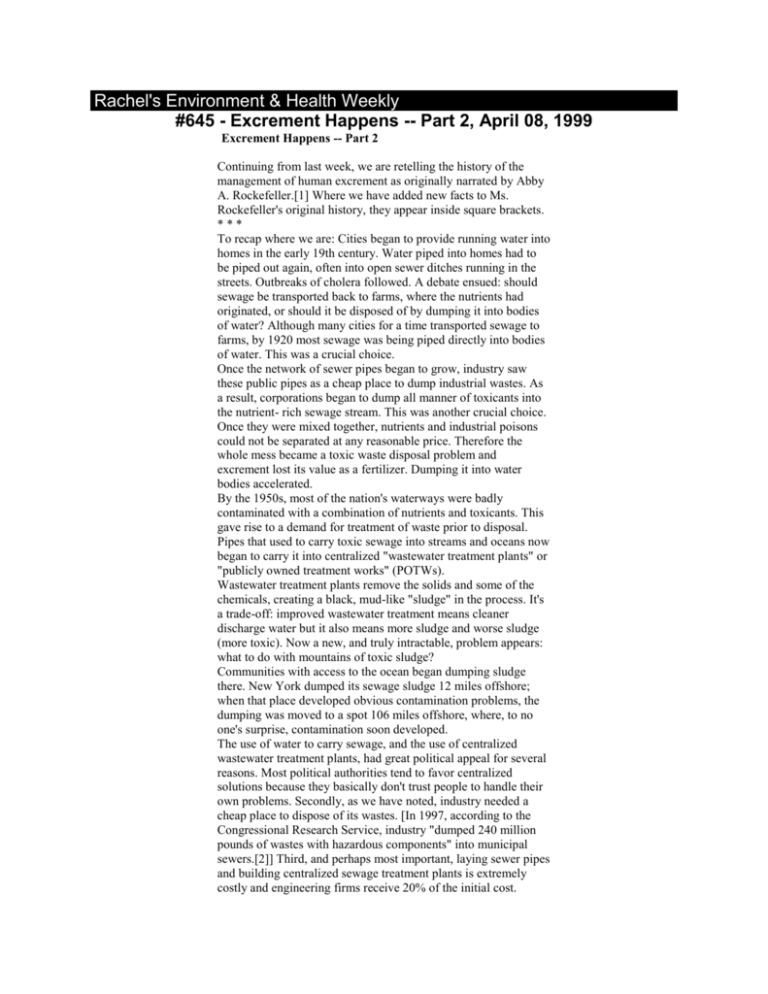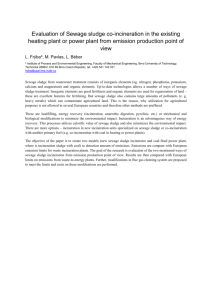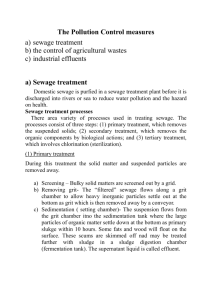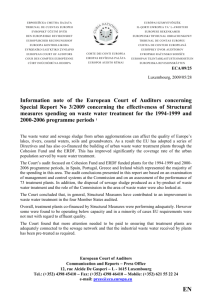RHEW_645_-_Excrement_Happens_--_Part_2
advertisement

Rachel's Environment & Health Weekly #645 - Excrement Happens -- Part 2, April 08, 1999 Excrement Happens -- Part 2 Continuing from last week, we are retelling the history of the management of human excrement as originally narrated by Abby A. Rockefeller.[1] Where we have added new facts to Ms. Rockefeller's original history, they appear inside square brackets. *** To recap where we are: Cities began to provide running water into homes in the early 19th century. Water piped into homes had to be piped out again, often into open sewer ditches running in the streets. Outbreaks of cholera followed. A debate ensued: should sewage be transported back to farms, where the nutrients had originated, or should it be disposed of by dumping it into bodies of water? Although many cities for a time transported sewage to farms, by 1920 most sewage was being piped directly into bodies of water. This was a crucial choice. Once the network of sewer pipes began to grow, industry saw these public pipes as a cheap place to dump industrial wastes. As a result, corporations began to dump all manner of toxicants into the nutrient- rich sewage stream. This was another crucial choice. Once they were mixed together, nutrients and industrial poisons could not be separated at any reasonable price. Therefore the whole mess became a toxic waste disposal problem and excrement lost its value as a fertilizer. Dumping it into water bodies accelerated. By the 1950s, most of the nation's waterways were badly contaminated with a combination of nutrients and toxicants. This gave rise to a demand for treatment of waste prior to disposal. Pipes that used to carry toxic sewage into streams and oceans now began to carry it into centralized "wastewater treatment plants" or "publicly owned treatment works" (POTWs). Wastewater treatment plants remove the solids and some of the chemicals, creating a black, mud-like "sludge" in the process. It's a trade-off: improved wastewater treatment means cleaner discharge water but it also means more sludge and worse sludge (more toxic). Now a new, and truly intractable, problem appears: what to do with mountains of toxic sludge? Communities with access to the ocean began dumping sludge there. New York dumped its sewage sludge 12 miles offshore; when that place developed obvious contamination problems, the dumping was moved to a spot 106 miles offshore, where, to no one's surprise, contamination soon developed. The use of water to carry sewage, and the use of centralized wastewater treatment plants, had great political appeal for several reasons. Most political authorities tend to favor centralized solutions because they basically don't trust people to handle their own problems. Secondly, as we have noted, industry needed a cheap place to dispose of its wastes. [In 1997, according to the Congressional Research Service, industry "dumped 240 million pounds of wastes with hazardous components" into municipal sewers.[2]] Third, and perhaps most important, laying sewer pipes and building centralized sewage treatment plants is extremely costly and engineering firms receive 20% of the initial cost. [Between 1970 and 1993, the federal government appropriated $69.5 billion for sewage construction projects. The Congressional Research Service recently estimated that between now and the year 2016 (17 years), the federal government will spend another $126 billion on sewage projects. [2] These are serious amounts of money.] Only the Federal Highway Administration [and the military] spend more public money on construction. [If even a small fraction of this sewer money is kicked back at election time by consultants, lawyers, investment bankers and engineering firms, it can go a long way toward keeping the present crop of politicians in office.] In the 1970s, many environmentalists and public health officials favored centralized sewage treatment because it seemed to offer an improvement over dumping raw wastes into waterways. The Clean Water Act of 1977 was essentially a sewering act. Everyone was then locked into centralized wastewater treatment systems. In 1988, Congress discovered that sludge dumping in the oceans was harming marine life, and the practice was banned as of 1992. This created a massive problem for American cities: [11.6 billion pounds of sludge (that's the dry weight, not counting the water it contains[3]) has to go somewhere, year after year.] At that moment, EPA decided that the U.S. now needs to mimic 100 generations of successful farmers in Asia, returning human excrement to farmland. However, EPA has overlooked two important differences between modern sewage sludge and traditional "night soil" (unadulterated human waste): 1) Most of the nitrogen in human waste is in the urine and is water- soluble, so it is not captured in the sludge. Therefore, if sludge is going to substitute for commercial fertilizer, you have to use a lot of it to get enough nitrogen. And (2) when you add a lot of sludge to soil, you are also adding a lot of toxic metals and a rich (though very poorly understood) mixture of organic chemicals and, very likely, radioactive wastes as well. EPA has addressed the toxic metals by telling farmers to add lime to their soil along with the sewage sludge, to prevent the soil from becoming acidic. If soil turns acidic, then toxic metals begin to move around, either leaching down into groundwater or moving upward into the crops (which, by definition, are part of some food chain). If soils are alkaline (the opposite of acidic), the metals move more slowly. [What EPA has overlooked is the fact that ordinary rain is slightly acidic, not counting the excess acidity provided by "acid rain." Normal rain drops falling through the atmosphere dissolve small amount of carbon dioxide, forming carbonic acid. Normal rain has a pH of 5.6 whereas 7 is neutral. Therefore, if soils are not kept alkaline by the regular addition of lime, sooner or later normal rain will begin to leach excess metals out of many soils. The only way to prevent this is to keep the excess metals out of soils in the first place.] In sum, plowing sewage sludge into soils is essentially guaranteed to harm many of those soils as time passes. [See REHW #561.] [As we know from the ancients who poisoned their soils with irrigation salts, a nation that poisons its farmland is a nation that doesn't have a long- term future.] A series of bad decisions made during this century has brought us to an impasse: sewage sludge is unmanageable because you can't know from day to day what is going to be in it, and so you cannot monitor its contents.[4] (Even if you could manage the scientific problems inherent in monitoring an unknown mixture of unknown substances, as a practical matter there isn't any government agency with enough staff to monitor the nation's sludge.) Therefore -- as heroic a task as this may seem -- it is time to rethink centralized water-carriage sewage treatment systems. The present systems were not designed to produce useable products and therefore the DESIGN of present systems is the root of the problem. Three policy goals are needed: (1) Sewer avoidance (stay off or get off water-carriage, centralized sewer systems). (2) Promote low-cost, on- site resource recycling technologies, such as composting toilets, that avoid polluting water and preclude wasting resources. (3) Price water right so that the market works to keep it clean, not contaminate it with excreta.[4] [For individual households, real solutions are already available: zero discharge household waste systems. An excellent new book by David del Porto and Carol Steinfeld, THE COMPOSTING TOILET SYSTEM, will dispel any fears you may have that composting toilets are a step backward.[5] With microflush toilets and vacuum-flush toilets now readily available, you can have the bathroom of your dreams, yet compost your household wastes into an odor-free product that is entirely satisfactory as agricultural fertilizer. These days, there are companies that will manage the system for you, including removing the compost. Your household waste system can be installed, maintained, and managed by professionals, just like your electrical and heating systems. But what about apartment buildings and office buildings in cities? Although we know of no one who has applied it, the technology certainly exists for manufacturing building-scale waste systems based on anaerobic digesters, which would produce methane gas and fertilizer. As Abby A. Rockefeller said recently in an interview, "Surely, human ingenuity can do this." Such systems would be cheaper than current sewage systems because they wouldn't require miles of underground pipes to connect to a centralized sewage treatment plant, and they would conserve hundreds of billions of gallons of water each year. [Every time we flush the toilet, 3.3 gallons of drinking water are degraded. At 5.2 flushes per day (average), each of us presently degrades 6260 gallons of drinking water each year to flush away our 1300 pounds of excrement -- 1.6 trillion gallons of water per year in the U.S.] Naturally, we would need to keep toxicants out of these composting systems, but that has always been true (even though we have ignored this fact) and we might as well face up to it now. Toxic household products will have to be phased out as part of any plan for sustainable living. Toxic industrial wastes should be managed by the industries that make them, not dumped into the environment that sustains all life. Unusable wastes are a sure sign of inefficiency. Lastly, what to do with today's mountains of toxic sludge? Obviously they must be handled as hazardous wastes because that's what they are. [Probably above-ground storage in concrete buildings is the only satisfactory solution at the present time. (See REHW #260.)] [You say we can't do any of this because we've been doing it another way for 100 years? Ask yourself, what kind of people would dump their excreta into their drinking water in the first place? And what kind of people, faced with workable, cheaper, more environmentally sound alternatives would continue to insist that dumping their excreta into their drinking water is the only way to live?] -Peter Montague (National Writers Union, UAW Local 1981/AFL-CIO) ===== [1] Abby A. Rockefeller, "Civilization and Sludge: Notes on the History of the Management of Human Excreta," CURRENT WORLD LEADERS Vol. 39, No. 6 (December 1996), pgs. 99113. Ms. Rockefeller is president of the ReSource Institute for Low Entropy Systems, 179 Boylston St., Boston, MA 02130; telephone (617) 524-7258. [2] Claudia Copeland, WASTEWATER TREATMENT: OVERVIEW AND BACKGROUND [98-323 ENR] (Washington, D.C.: Congressional Research Service, January 20, 1999). Available at: http://- www.cnie.org/nle/h2o-29.html . [3] Gary D. Krauss and Albert L. Page, "Wastewater, Sludge and Food Crops," BIOCYCLE (February 1997), pgs. 74-82. Krauss was staff director for the National Research Council study, USE OF RECLAIMED WATER AND SLUDGE IN FOOD CROP PRODUCTION (Washington, D.C.: National Academy Press, 1996). [4] Robert Goodland and Abby Rockefeller, "What is Environmental Sustainability in Sanitation?" IETC'S INSIGHT [newsletter of the United Nations Environment Programme, International Environmental Technology Centre] Summer, 1996), pgs. 5-8. The International Environmental Technology Centre can be reached at: UNEP-IETC, 2-1110 Ryokuchikoen, Tsurumi-ku, Osaka 538, Japan. Telephone: (81-6) 915-4580; fax: (81-6) 9150304; E-mail: cstrohma@unep.or.jp; URL: http://www.unep.or.jp/. See also Abby A. Rockefeller, "Sewage Treatment Plants vs. the Environment," an unpublished paper dated September, 1997. And: Abby A. Rockefeller, "Sludge is Sludge; The Illusion of Safety," an unpublished paper dated June 26, 1996. Ms. Rockefeller is president of the ReSource Institute for Low Entropy Systems, 179 Boylston St., Boston, MA 02130; telephone (617) 524-7258. [5] David Del Porto and Carol Steinfeld, THE COMPOSTING TOILET SYSTEM BOOK (Concord, Mass.: Center for Ecological Pollution Prevention, 1999). ISBN 0-9666783-0-3. See http://www.ecological- engineering.com/ctbook.html; $29.95 plus $3.30 shipping ($12 overseas shipping) from: Center for Ecological Pollution Prevention, 50 Beharrell St., P.O. Box 1330, Concord, Mass. USA 01742. Phone (978) 369-9440. Fax: (978) 368-2484. E-mail: ecop2@hotmail.com. See also: Carol Steinfeld, "Composting Toilets Come to the Rescue in Massachusetts," BIOCYCLE (April 1996), pgs. unknown. See http://- www.ecological-engineering.com/rescue.html And see: Carol Steinfeld, "Composting Toilets Emerge as Viable Alternatives," Environmental Design & Construction (July/August 1998), pgs. unknown. See http://www.edcmag.com/archives/7-98-14.htm. Descriptor terms: sewage; human waste; sludge; agriculture; hazardous waste; compost; sewage treatment systems; topback to the top Rachel's Environment & Health Weekly is a publication of the Environmental Research Foundation, P.O. Box 5036, Annapolis, MD 21403 .. Fax (410) 263-8944; Internet: erf@rachel.org. Back issues available by E-mail; to get instructions, send E-mail to INFO@rachel.org with the single word HELP in the message; back issues also available via ftp from ftp.std.com/periodicals/rachel, from gopher.std.com, from http://www.rachel.org. Subscriptions are free. To subscribe, E-mail the words SUBSCRIBE RACHEL-WEEKLY YOUR NAME to: listserv@rachel.org NOTICE: Environmental Research Foundation provides this electronic version of RACHEL'S ENVIRONMENT & HEALTH WEEKLY free of charge even though it costs our organization considerable time and money to produce it. We would like to continue to provide this service free. You could help by making a taxdeductible contribution (anything you can afford, whether $5.00 or $500.00). Please send your tax-deductible contribution to: Environmental Research Foundation, P.O. Box 5036, Annapolis, MD 21403-7036. Please do not send credit card information via E-mail. For further information about making tax-deductible contributions to E.R.F. by credit card please phone us toll free at 1-888-2RACHEL. --Peter Montague, Editor






